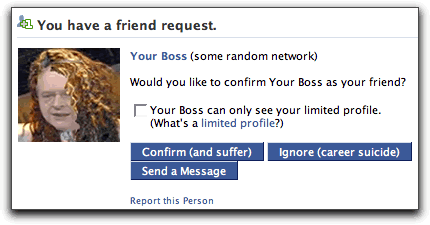Would You Like to Confirm Your Boss as Your Friend?

Transgender Jakob Nielsen isn’t my boss, but he thinks he is.
If it’s not one boss, it’s another. If you’re not freaking out because your mom “friended” you on Facebook, there’s still the chance that your boss might, meaning that he or she may be privy to your extracurricular indiscretions. The Wall Street Journal looks at this dilemma in OMG — My Boss Wants to ‘Friend’ Me On My Online Profile.
What you may want to keep in mind if faced with the decision of whether or not to “friend” your boss is that the openness works both ways:
Paul Dyer was always able to hold off his boss’s invitations to party by employing that arms-length response: “We’ll have to do that sometime,” he’d say.
But when his boss, in his 30s, invited Mr. Dyer, 24 years old, to be friends on the social-networking sites MySpace and Facebook, dodging wasn’t so easy. On the one hand, accepting a person’s request to be friends online grants them access to the kind of intimacy never meant for office consumption, such as recent photos of keggers and jibes from friends. (“Still wearing that lampshade?”)
But declining a “friend” request from a colleague or a boss is a slight. So, Mr. Dyer accepted the invitation, then removed any inappropriate or incriminating photos of himself — “I’d rather speak vaguely about them,” he says — and accepted the boss’s invitation.
Mr. Dyer, it turns out, wasn’t the one who had to be embarrassed. His boss had photos of himself attempting to imbibe two drinks at once, ostensibly, Mr. Dyer ventures, to send the message: “I’m a crazy, young party guy.” The boss also wore a denim suit (“I’d never seen anything like it,” Mr. Dyer says) and posed in a photo flashing a hip-hop backhand peace sign.
It was painful to watch. “I hurt for him,” says Mr. Dyer.
My Own Situation
My boss, Leona Hobbs, is my friend on a number of social networks, as is my old boss Ross Rader. The powers that be at Tucows are aware of my blog and read it every now and again; in fact, a lot of the credit to my getting hired has to go to a number of personal blog entries of mine at The Adventures of Accordion Guy in the 21st Century. Everyone here is aware of my blogs and the goofy stuff I sometimes put in them.
I’m reminded of what someone at the DefCon conference back in 2000 told me. He was a guy who worked at a U.S. military site but whose major was in Marxist Studies. I asked if having how he managed to get a job like his with a degree like his, and he replied by saying that they hired him because he was open about it. Had he tried to keep it a secret, someone could use that secret to blackmail him. I suppose the moral of the story is that if you’ve got a reasonably open-minded boss (and proclivities that aren’t too far out there), openness might be the best policy.





















